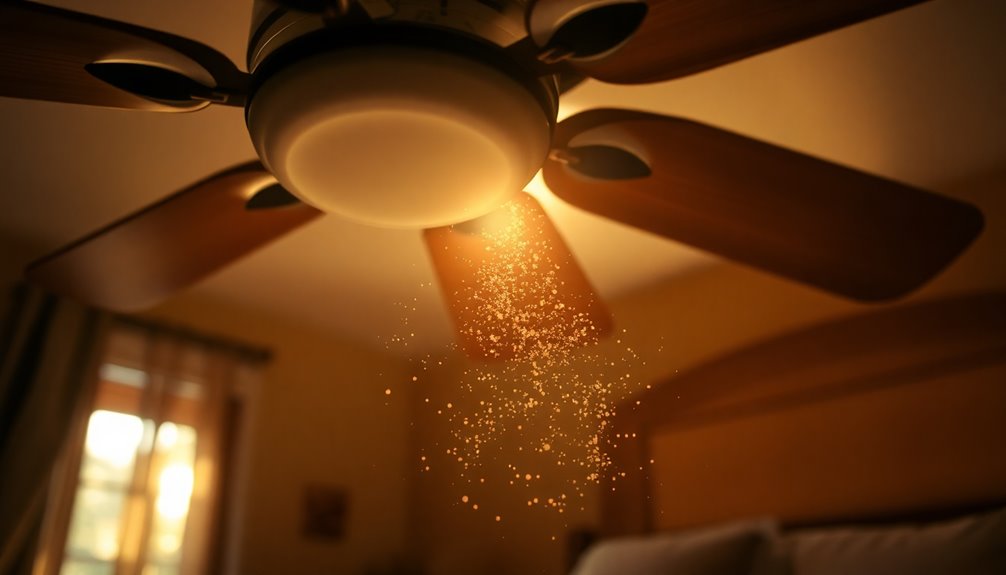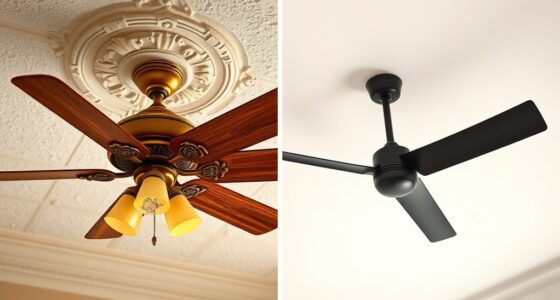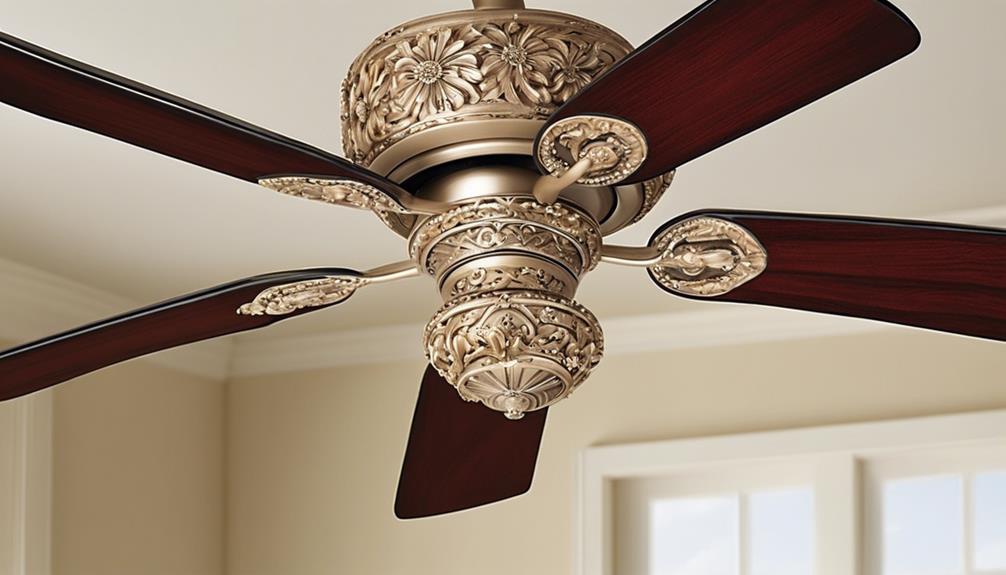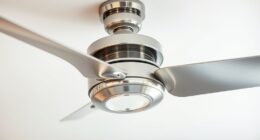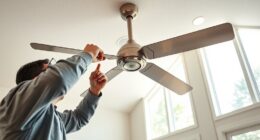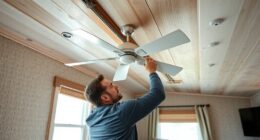If you can't feel your ceiling fan's breeze, it's likely due to improper installation or airflow issues. Check the fan's rotation direction; it should spin counterclockwise for cooling. Also, make certain the fan's blades are adequately sized and pitched for peak airflow. Don't forget to clear any obstructions nearby that might block air movement. Proper installation height is vital too; fans should be at least 2.1 meters from the floor. Finally, regular cleaning and maintenance are essential for performance. Stick around, and you'll uncover more tips to boost your ceiling fan's effectiveness.
Key Takeaways
- Ensure the fan's rotation direction is set to counterclockwise for effective cooling and airflow.
- Check for obstructions around the fan blades that may restrict air movement.
- Confirm the fan is installed at least 2.1 meters from the floor for optimal airflow.
- Inspect the blade size; blades below 48 inches may not produce sufficient airflow.
- Perform regular maintenance, including cleaning blades and checking electrical connections for any issues.
Common Causes of Poor Airflow
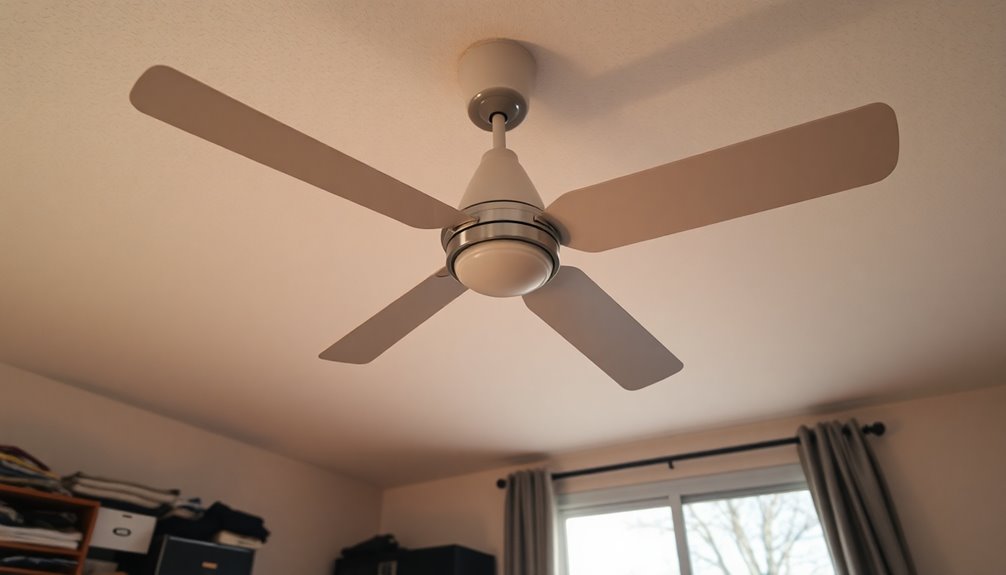
Experiencing poor airflow from your ceiling fan can be frustrating, but identifying the common causes can help you remedy the issue. One major factor is the rotation direction of your fan. If it's set incorrectly, it won't create that invigorating wind chill effect you expect. Confirm your fan is rotating counterclockwise during the warmer months for ideal cooling.
Another cause can be the size of the fan blades. If the blades are too small, typically less than 48 inches, they may not generate enough airflow for your space.
You should also check the installation. A tilted base can greatly impact airflow, so verify your fan is level and securely installed.
Don't overlook the proximity of the fan blades to the ceiling. If there's insufficient clearance, it can restrict air movement.
Finally, pay attention to any electrical issues. Blown fuses or faulty wiring can prevent your fan's motor from functioning properly, affecting airflow even if the fan seems operational. If you suspect electrical problems, it's best to call a professional for inspection and repair.
Troubleshooting Fan Direction Issues
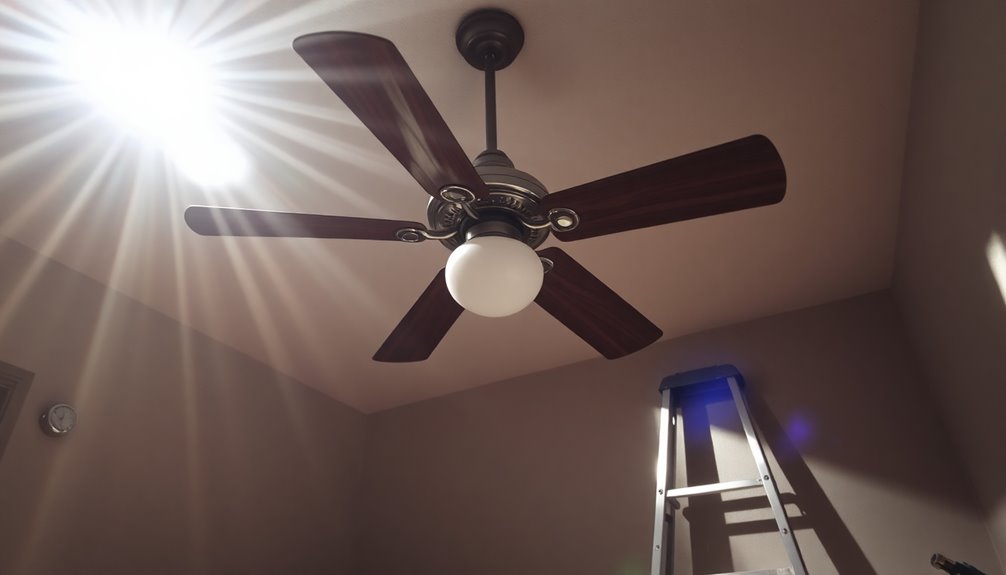
Troubleshooting fan direction issues can often resolve the feeling of inadequate airflow in your space. First, check the rotation direction of your ceiling fan using the switch on the fan motor. For ideal cooling, the fan should rotate counterclockwise, creating a downdraft that pushes air directly toward you. If it's rotating clockwise, it might be pushing air upwards, leaving you feeling stagnant.
Next, examine the blade pitch angle. A steeper pitch enhances airflow, so if your fan blades are too flat, it could limit air movement.
Additionally, verify that no nearby objects obstruct the blades. Even the best fan can struggle if something's in the way, hindering effective airflow.
To test if your fan is pushing air correctly, use lightweight materials like helium balloons or toilet paper squares. If you see them moving, your fan's downdraft is working. If they stay still, you may need to adjust the fan's rotation direction or check for obstructions.
Importance of Proper Installation

Proper installation of your ceiling fan is crucial for maximizing airflow and guaranteeing comfort in your space. To achieve this, you need to take into account the proper installation height. Fans should be mounted at least 2.1 meters from the floor to prevent airflow obstruction and enhance air movement.
Additionally, verify that the fan's base is level; a tilted base can hinder blade rotation, reducing the fan's cooling effectiveness.
The blade pitch and size also play significant roles in performance. Ideally, blades should range from 48 to 60 inches to optimize airflow without creating excessive resistance.
Furthermore, maintaining sufficient clearance from the ceiling is essential; being too close can limit air movement and diminish overall cooling effectiveness. Moreover, selecting a fan with energy-efficient motors can greatly enhance its performance and reduce electricity costs.
Maintenance Tips for Optimal Performance
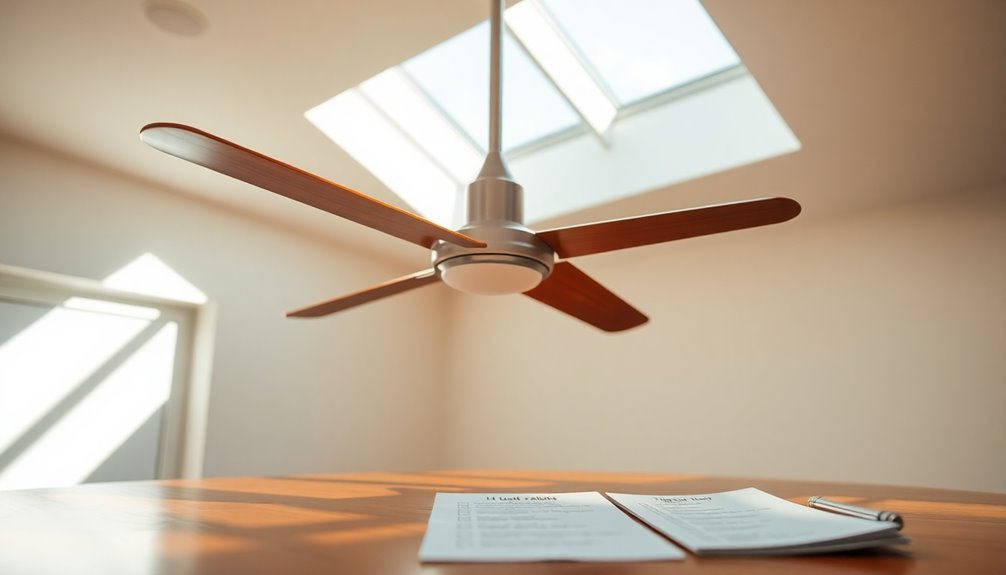
To keep your ceiling fan running smoothly and efficiently, regular maintenance is key. Start by using your ceiling fan remote to adjust settings, but if the fan isn't blowing as it should, it's time to investigate.
First, make certain to clean fan blades regularly to remove dust and debris, which can hinder airflow and reduce performance. Regularly cleaning your fan blades can also help reduce allergens such as dust that may circulate in the air.
Next, check for obstructions around the fan that might impede air movement. Remove any items that could block airflow to guarantee ideal performance.
Periodically inspect the wiring and connections for wear and tear; this guarantees a consistent electrical supply and functionality.
Don't ignore any unusual sounds during operation. These sounds may indicate mechanical problems that require immediate attention to maintain your fan's performance.
Additionally, ensure that your ceiling fan is installed with proper ventilation to prevent any airflow issues that could impact its efficiency.
If you notice anything out of the ordinary, it's wise to schedule periodic professional maintenance. This will help address any potential mechanical issues and guarantee your ceiling fan operates at its best.
User Experiences and Solutions
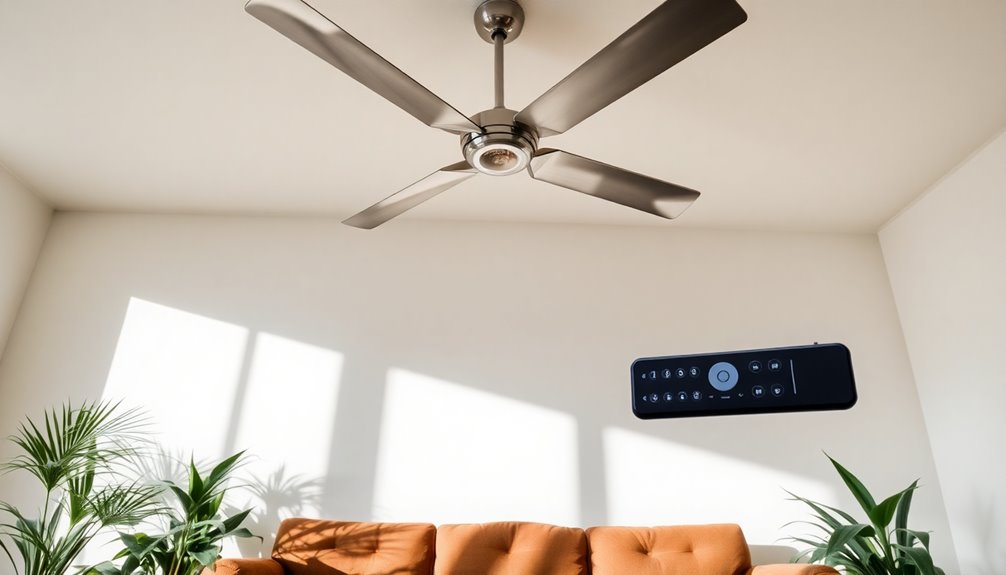
When it comes to feeling the airflow from your ceiling fan, many users have shared their experiences and solutions that can help you troubleshoot the issue.
First, check the direction of your fan's rotation. If it's set to clockwise, it mightn't be pushing air down effectively. Make sure it's running counterclockwise for best airflow.
If your ceiling fan isn't blowing air as expected, consider the size and pitch of the blades; larger blades (48 to 60 inches) generally move more air.
Installation height is another key factor. Verify your fan is at least 2.1 meters from the floor for safety and efficiency.
Some users recommend easy-to-install testing methods, like observing lightweight materials (toilet paper or helium balloons) to see if the air movement is adequate.
Don't forget about regular maintenance. Cleaning the blades and checking connections can greatly enhance performance.
If you have an older fan, it may require more attention. If airflow is still lacking, you might need to reposition the fan or even consider upgrading to a newer model that better suits your space.
Frequently Asked Questions
Why Don't I Feel Air From My Ceiling Fan?
If you don't feel air from your ceiling fan, check a few things.
First, make certain it's spinning in the right direction; it should rotate counterclockwise for cooling.
Next, examine the blade size; they should ideally be between 48 to 60 inches for effective airflow.
Also, verify the fan is level and installed at least 2.1 meters from the floor.
If everything looks good, there may be electrical issues needing a professional's help.
Why Can't I Feel Anything From My Fan?
If you can't feel anything from your fan, check its rotation direction first. You need it to spin counterclockwise for cooling airflow.
Also, verify the blades are long enough for your room size; short blades may not push enough air.
Look for any installation issues that might tilt the fan, and make sure it's not too close to the ceiling.
Finally, inspect for electrical problems like loose wiring or a faulty motor.
Why Does It Feel Like My Ceiling Fan Is Not Working?
If it feels like your ceiling fan isn't working, check a few things.
First, verify it's set to rotate counterclockwise for cooling.
Next, look at the blade size and pitch; smaller blades mightn't move enough air.
Also, make sure it's installed at least 2.1 meters from the floor and that the base is level.
Finally, inspect for any electrical issues, like loose wiring, that could affect performance.
How Can I Improve the Airflow in My Ceiling Fan?
To really get the ball rolling on improving your ceiling fan's airflow, start by ensuring it's spinning counterclockwise in the summer.
Check that it's at least 2.1 meters from the floor to maximize circulation.
If your fan blades are small, consider swapping them for larger ones to enhance efficiency.
Don't forget to clean the blades regularly and level the base, as a tilted fan can throw a wrench in your airflow plans.
Conclusion
To summarize, if you can't feel your ceiling fan's airflow, it could stem from improper installation, direction issues, or even dust buildup. Curiously, some believe that fans circulate air more effectively in the summer when set to spin counterclockwise. In reality, both clockwise and counterclockwise settings serve different purposes. Regular maintenance and checking the fan's direction can make a big difference. So, take a moment to troubleshoot and enjoy the comfort your ceiling fan can truly provide!
